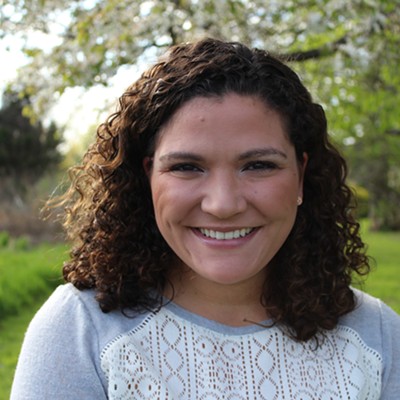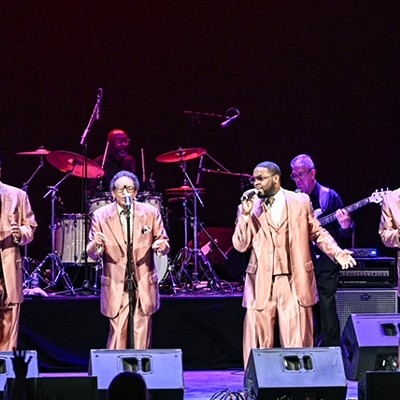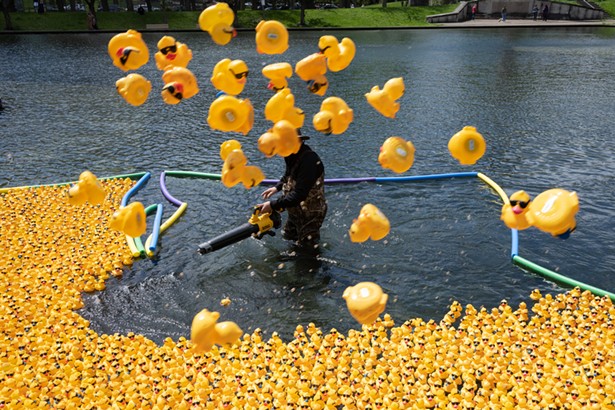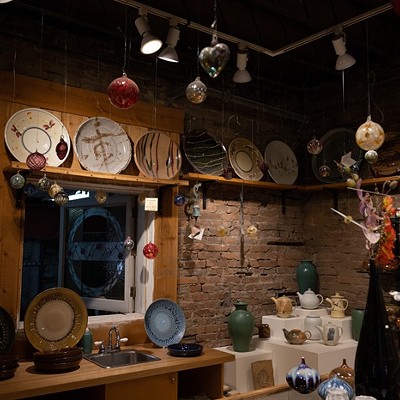Murrysville-born experimental musician Andrea Parkins approaches her work from a Rube Goldbergian perspective
“All of these things put together are moving something through time.”
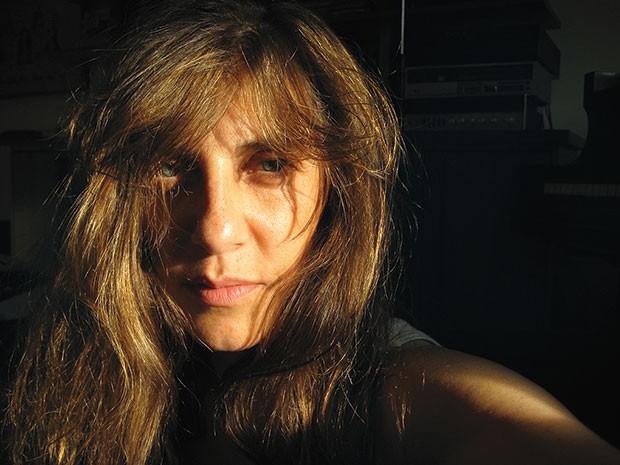
"I have to be on my toes”: Andrea Parkins
ANDREA PARKINS with MORTIS, VALERIE KUEHNE
8 p.m. Fri., Dec. 23. Palanzo’s, 4614 Penn Ave., Bloomfield. $10. All ages. 412-682-0591
Rube Goldberg was not a musician. Primarily a cartoonist, he came to prominence for illustrations of devices that performed simple tasks through elaborate set of mechanisms. Goldberg’s legend was solidified by the board game Mousetrap, which uses that same concept. The term “Rube Goldberg machine” also came to represent any device with a complex series of steps.
Despite Goldberg’s work in other disciplines, he also inspired musician Andrea Parkins. “It’s like pre-analog processing of an object,” she says, in describing the cartoonist’s work. “You push something — either it’s gravity or it’s force that pushes an object along. Then it runs into another object and causes something else to happen, which causes something else to happen, etc. I love that idea as a model. I like how intricate some of those machines are.”
In her solo performances, she uses a laptop computer, which she refers to as “Goldberg.” It functions as a “virtual instrument.” Although it uses modern technology like sampling and processing, a Goldbergian process is what gets it there, such as when Parkins’ homemade collection of field recordings blends with her accordion playing or live sampling of objects. “All of these things put together are moving something through time — like a series of events through time — which makes a composition and comes to a result of some kind,” she says.
Parkins’ approach to music incorporates an exploration of various musical styles and studies that also involve visual arts. A native of Murrysville, she started off playing classical piano but developed an interest in more adventurous musical elements even at a young age. “I was always attracted to dissonance and texture and timbre change,” she says, on the phone from New York. “When I think back to all the music that I really enjoyed the most as a kid, I liked listening to the Brandenburg Concertos [by Bach], but I liked listening to them in the original instrumentation. I liked Thelonious Monk, I liked Stravinsky, I liked Kurt Weill. You get the picture.”
Music school wasn’t the ideal place for Parkins, and she dropped out of Boston’s Berklee School (now College) of Music after two years. She began studying improvisation privately and playing synthesizer in rock bands. Art school, on the other hand, proved to be a revelation. “I started taking experimental film class with Phil Solomon, who was a protégé of Stan Brakhage,” she says. “[The way] he was talking about film, which was super-structural and semiotic and a lot about atmospheres and associativeness — all the poetics of cinema. And I started thinking, ‘Why can’t I do that with sound?’ And that was a great beginning for me to think about sound in a different way.”
Along the way, a bandmate gave Parkins an accordion, the instrument for which she is probably best known. From the get-go, her approach to the squeezebox had nothing to do with its traditional use. “I was really interested in it as a synthesizer or sound machine,” Parkins says. “I put a pickup into it and started exploring stuff with some guitar effects. So that’s been kind of a part of my palette since then.”
Parkins eventually moved to New York where she’s played and recorded in a number of projects with wide-ranging styles. For 16 years, she played accordion and sampler in a trio with the adventurous saxophonist Ellery Eskelin and the equally freewheeling drummer Jim Black. More recently, she released Avalanche of Routes, an album with Brian Chase, drummer of the Yeah Yeah Yeahs. Fully improvised, it incorporates drone and feedback, since Chase amplifies and samples his drum heads while playing, which blends with Parkins’ own use of samples and sonic manipulations.
In a solo performance, Parkins uses the accordion as well as her laptop (Goldberg) extensively, but she explains that a performance doesn’t simply consist of pressing buttons on a keypad. “The way I’m working with the computer, I’m trying to remember what I did as a pianist, which was a physical engagement,” she says. “I’m really thinking about the computer that way, so that I’m not just sitting there with a laptop. I’m actually addressing it physically in kind of an exchange between me and an instrument.”
Since improvisation plays a big role in her performances, Parkins makes sure that the element of chance can also shape a performance. “The processing has a system, but built into it is a possibility that it might not work,” she says. “Or it might go in a direction that I don’t know it will go. If I’m improvising with the processed material on another instrument, I have to be on my toes. I have to be listening with all my might and be ready to jump in and respond sonically.”
Despite Goldberg’s work in other disciplines, he also inspired musician Andrea Parkins. “It’s like pre-analog processing of an object,” she says, in describing the cartoonist’s work. “You push something — either it’s gravity or it’s force that pushes an object along. Then it runs into another object and causes something else to happen, which causes something else to happen, etc. I love that idea as a model. I like how intricate some of those machines are.”
In her solo performances, she uses a laptop computer, which she refers to as “Goldberg.” It functions as a “virtual instrument.” Although it uses modern technology like sampling and processing, a Goldbergian process is what gets it there, such as when Parkins’ homemade collection of field recordings blends with her accordion playing or live sampling of objects. “All of these things put together are moving something through time — like a series of events through time — which makes a composition and comes to a result of some kind,” she says.
Parkins’ approach to music incorporates an exploration of various musical styles and studies that also involve visual arts. A native of Murrysville, she started off playing classical piano but developed an interest in more adventurous musical elements even at a young age. “I was always attracted to dissonance and texture and timbre change,” she says, on the phone from New York. “When I think back to all the music that I really enjoyed the most as a kid, I liked listening to the Brandenburg Concertos [by Bach], but I liked listening to them in the original instrumentation. I liked Thelonious Monk, I liked Stravinsky, I liked Kurt Weill. You get the picture.”
Music school wasn’t the ideal place for Parkins, and she dropped out of Boston’s Berklee School (now College) of Music after two years. She began studying improvisation privately and playing synthesizer in rock bands. Art school, on the other hand, proved to be a revelation. “I started taking experimental film class with Phil Solomon, who was a protégé of Stan Brakhage,” she says. “[The way] he was talking about film, which was super-structural and semiotic and a lot about atmospheres and associativeness — all the poetics of cinema. And I started thinking, ‘Why can’t I do that with sound?’ And that was a great beginning for me to think about sound in a different way.”
Along the way, a bandmate gave Parkins an accordion, the instrument for which she is probably best known. From the get-go, her approach to the squeezebox had nothing to do with its traditional use. “I was really interested in it as a synthesizer or sound machine,” Parkins says. “I put a pickup into it and started exploring stuff with some guitar effects. So that’s been kind of a part of my palette since then.”
Parkins eventually moved to New York where she’s played and recorded in a number of projects with wide-ranging styles. For 16 years, she played accordion and sampler in a trio with the adventurous saxophonist Ellery Eskelin and the equally freewheeling drummer Jim Black. More recently, she released Avalanche of Routes, an album with Brian Chase, drummer of the Yeah Yeah Yeahs. Fully improvised, it incorporates drone and feedback, since Chase amplifies and samples his drum heads while playing, which blends with Parkins’ own use of samples and sonic manipulations.
In a solo performance, Parkins uses the accordion as well as her laptop (Goldberg) extensively, but she explains that a performance doesn’t simply consist of pressing buttons on a keypad. “The way I’m working with the computer, I’m trying to remember what I did as a pianist, which was a physical engagement,” she says. “I’m really thinking about the computer that way, so that I’m not just sitting there with a laptop. I’m actually addressing it physically in kind of an exchange between me and an instrument.”
Since improvisation plays a big role in her performances, Parkins makes sure that the element of chance can also shape a performance. “The processing has a system, but built into it is a possibility that it might not work,” she says. “Or it might go in a direction that I don’t know it will go. If I’m improvising with the processed material on another instrument, I have to be on my toes. I have to be listening with all my might and be ready to jump in and respond sonically.”


